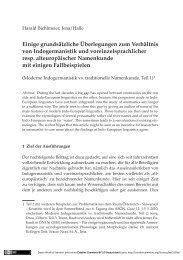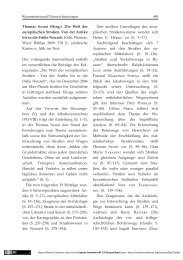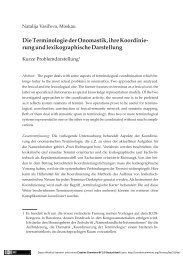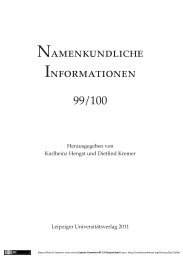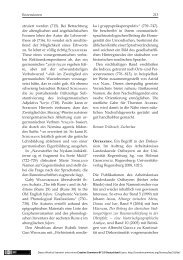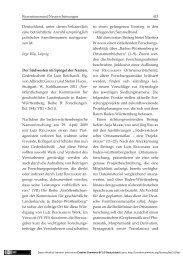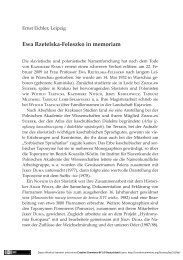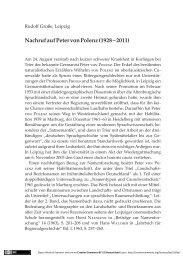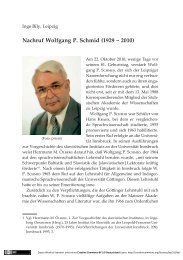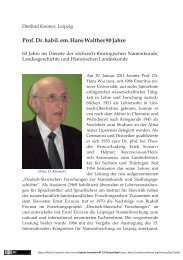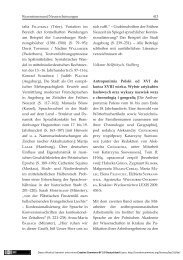Proper Names in the Light of Theoretical Onomastics
Proper Names in the Light of Theoretical Onomastics
Proper Names in the Light of Theoretical Onomastics
You also want an ePaper? Increase the reach of your titles
YUMPU automatically turns print PDFs into web optimized ePapers that Google loves.
<strong>Proper</strong> <strong>Names</strong> In <strong>the</strong> <strong>Light</strong> <strong>of</strong> <strong>Theoretical</strong> <strong>Onomastics</strong>139entry as well as o<strong>the</strong>r data is closely related to <strong>the</strong> content aspect <strong>of</strong> <strong>the</strong>processed onymy. As for toponyms, <strong>the</strong>re is a direct relation between <strong>the</strong>name and <strong>the</strong> location where <strong>the</strong> object is situated. With reference to motivation,<strong>the</strong> orig<strong>in</strong>al nam<strong>in</strong>g circumstances are outl<strong>in</strong>ed. In respect <strong>of</strong> <strong>the</strong>identification role <strong>of</strong> a generic particularity named <strong>in</strong> ord<strong>in</strong>ary communication,a k<strong>in</strong>d <strong>of</strong> de-semantisation <strong>of</strong> <strong>the</strong> named lexeme takes place. Innames which are already non-existent, <strong>the</strong> lexical elements are reta<strong>in</strong>ed (cf.e. g. debra, chopok, nákel, chríp // hríb, m<strong>in</strong>čol, beskyd // beščaď etc. – Majtán1996).In historical lexicons, an entry can be arranged <strong>in</strong> two ways. A typologicalheadword stems from <strong>the</strong> contemporary status <strong>of</strong> a toponymic factand <strong>the</strong> entry is constructed on <strong>the</strong> pr<strong>in</strong>ciple <strong>of</strong> retrospection. The entryhas four parts: a source headword (<strong>in</strong> current form or <strong>in</strong> <strong>the</strong> form <strong>of</strong> <strong>the</strong>period); heuristic basis (records <strong>of</strong> historical documents listed retrospectively);l<strong>in</strong>guistic basis (reconstruction <strong>of</strong> its form and content); comment(verification data). A genetic entry is constructed as follows: a sourceheadword (<strong>in</strong> <strong>the</strong> period or reconstructed Proto-Slavic form, grammaticaldata, <strong>the</strong> mean<strong>in</strong>g <strong>of</strong> <strong>the</strong> headword and historical word-form<strong>in</strong>g analysis<strong>of</strong> <strong>the</strong> word); progress <strong>of</strong> toponymisation; heuristic basis (from <strong>the</strong> oldestdocument to more recent ones); comment (with additional <strong>in</strong>formation)(Krajčovič 1983, 19 –22).In anthroponymy, <strong>of</strong>ficial and un<strong>of</strong>ficial names are dist<strong>in</strong>guished. Inun<strong>of</strong>ficial names, <strong>the</strong> motivation driv<strong>in</strong>g <strong>the</strong> nam<strong>in</strong>g is clear and live (Holý– Oblečsa-Naked – Getdressed, Hnilička – Plesnivý-Rotte – Mouldy, Úsečka-Abscissa, Veľká Hlava – Big Head ). The same can be stated for <strong>the</strong> so-calledambimodal chrematonyms (compare Vydavateľstvo časopisov a novín – Publish<strong>in</strong>gHouse <strong>of</strong> Magaz<strong>in</strong>es and Newspapers, Letecký úrad Slovenskej republiky– <strong>the</strong> Office <strong>of</strong> Aviation <strong>of</strong> <strong>the</strong> Slovak Republic, Automatizácia železničnej dopravy– Automatisation <strong>of</strong> Railway Transport ). These classes <strong>of</strong> onymy makeit possible to classify <strong>the</strong>ir motivational features and to <strong>in</strong>vestigate how<strong>the</strong> nam<strong>in</strong>g procedures are used. The current problem is <strong>the</strong> exceptionallyextensive sets <strong>of</strong> surnames. In <strong>the</strong>ir lexicographic process<strong>in</strong>g, one has tocope with <strong>the</strong> consequences <strong>of</strong> <strong>the</strong> loss <strong>of</strong> motivation. Due to <strong>in</strong>her it<strong>in</strong>ga surname, <strong>the</strong> primary motivational features lose <strong>the</strong>ir relevance. For example,<strong>the</strong> surname Tokár – Turner recorded <strong>in</strong> an onomasticon does notname “a craftman who produces round wooden objects”; this etymologicalmean<strong>in</strong>g could probably relate to <strong>the</strong> first bearer <strong>of</strong> this name and notto a person who lives <strong>in</strong> <strong>the</strong> town T on <strong>the</strong> street S. As mentioned earlier,



